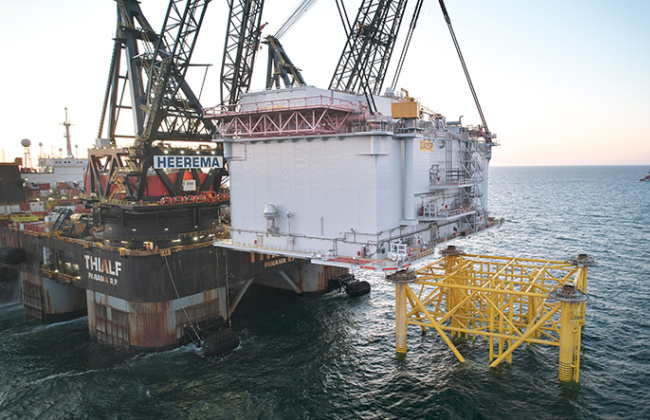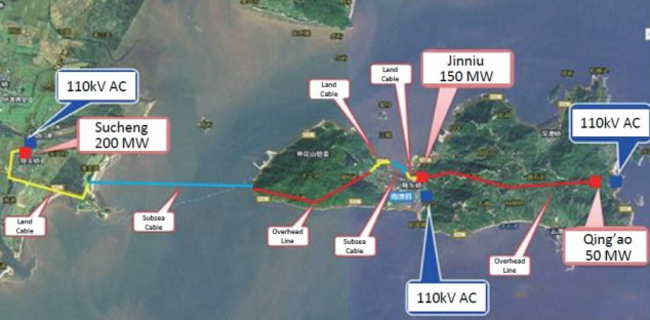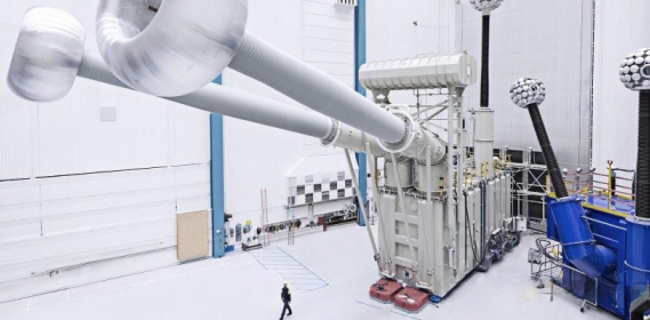The World’s First Unmanned HVDC Offshore Platform
The construction of Dogger Bank, which will become the world’s largest offshore wind farm, has reached another milestone with the installation of the world’s first unmanned high-voltage direct current (HVDC) offshore substation.
The substation is the first of three platforms supplied by Aibel to be installed at Dogger Bank, which is being built in three 1.2GW phases, A, B, and C.
The Dogger Bank A platform is 65 x 36 meters wide and 39 meters high and sits on a four-legged steel jacketed foundation structure anchored to the seabed at a water depth of approximately 28 meters.

Approximately 146 km from the nearest land, Flamborough Head (located off Bridlington in east Yorkshire), the platform’s installation was delivered by the main contractor Sapiem.
This innovative offshore platform is of lean design and is the first unmanned HVDC platform that will be operated from shore with access only by a service operation vessel. The platform will receive 1.2GW of AC power from Dogger Bank A’s 95 offshore wind turbines, convert it to DC and send it to an onshore converter station near Beverley in the East Riding of Yorkshire.
Equipped with Hitachi Energy’s latest generation high-voltage DC converter technology, Dogger Bank will be the first offshore wind project in the UK to use this technology to transmit the electricity produced back to shore, ensuring that the power is transmitted efficiently over long distances while minimizing losses.
Olly Cass, project director for the Dogger Bank wind farm, said: “The safe and successful installation of the offshore platform marks an important milestone for the Dogger Bank project. As the UK’s first HVDC platform for an offshore wind farm, it also marks an important milestone for the UK industry more generally.
“The platform will be controlled from shore and removing the need for personnel to remain on the platform means that elements such as living quarters, helicopter decks, and sewage systems can be removed, resulting in a 70% reduction in topside weight (per MW) compared to previous installations and hundreds of millions of pounds in cost savings.
“The team continues to make good progress in installing the turbine foundations and later in the second quarter, specialist cable installation and support vessels will begin installing the network of inter-array cables that will connect the turbines to the offshore platforms for the transmission of the first power over the summer.”
The Dogger Bank Wind Farm, a joint venture between SSE Renewables, Equinor, and Vårgrønn, will be the world’s largest offshore wind farm, consisting of 277 wind turbines. The wind farm will be able to generate 3.6 GW of renewable energy, which is enough to provide clean and sustainable electricity to more than 6 million households.

HVDC Transmission Has The Following Main Advantages Over HVAC Transmission:
1. When The Same Power Is Transmitted, The Cost Of DC Lines Is Lower
Three-phase AC power requires three wires for transmission, and the insulation of each wire to the ground should be designed according to its peak value (times the RMS value). While DC power requires only two wires (only one if it is unipolar) and the peak value of DC power is equal to the RMS value.
Therefore, DC transmission can save a lot of transmission materials, and also reduce a lot of transportation and installation costs.
Secondly, DC transmission has a simpler structure of overhead line towers, narrow line corridors, and cables with the same insulation level that can run at higher voltages.
2. DC Transmission Power Consumption Is Small
Because DC overhead lines use only one or two wires, the active loss is smaller, and has a “space charge” effect, it’s corona loss and radio interference are smaller than the AC overhead lines.
3. Suitable For Submarine Power Transmission
General AC power transmission is mostly overhead, the line and the earth form a capacitance. But because the composition of the air capacitance is very small, and the impact on the circuit transmission is very small.
However, for underground cables and submarine cables, as the cable and the land between the sea will form a larger capacitance. The capacitive resistance is smaller than the high-altitude erection. Which is equivalent to the formation of additional branches, which in turn causes additional line loss.
4. Reactive Angle Stability Problem
In an AC transmission system, all synchronous generators connected to the power system must be kept in synchronous operation.
If a DC line is used to connect two AC systems, the above stability problem does not exist because the DC line has no reactance. This means that DC transmission is not limited by the transmission distance.
5. Can Limit The Short-Circuit Current Of The System
When connecting two AC systems with AC transmission lines, the increase in system capacity will increase the short-circuit current.
Which may exceed the original circuit breaker’s interrupting capacity, which requires the replacement of a large number of devices, increasing the amount of investment. When DC transmission, there is no such problem.
6. Fast Adjustment Speed, Reliable Operation
DC transmission through a thyristor converter can easily and quickly adjust the active power and realize the tide flip.
If a bipolar line is used, when one pole fails, the other pole can still use earth or water as a circuit to continue to transmit half of the power, which also improves the reliability of operation.

VSC-HVDC System For Offshore Wind Power – Power Transmission
It was found that the VSC-HVDC system (Voltage Source Converter-High Voltage Direct Current) can control active and reactive power in time compared to conventional HVDC.
It is also able to perform remote transmission bargaining very well.
It has many functional features to make up for the problems encountered in the transmission of offshore wind power.
To solve the long-distance transmission of offshore wind power, improve its operational efficiency and system stability, as far as possible to reduce investment costs.
The study of a new high-voltage DC VSC-HVDC system in the operation of an offshore wind power transmission system is very necessary.
1. VSC-HVDC System Characteristics Analysis
In recent years, with the advancement of power electronics technology to promote a large number of DC projects into operation, making DC transmission control, protection, fault, reliability, and many other issues become more and more important.
VSC-HVDC The comprehensive application of this new technology makes DC transmission technology has new progress.
Its application appears to improve the quality of power supply to the AC grid to provide a new guarantee. Its characteristics are mainly in the following areas.
1.1 Efficiency And Energy Saving
VSC-HVDC technology power loss is lower than the loss of traditional AC transmission technology.
At the same time, HVDC requires fewer transmission cables, can reduce the footprint, is more energy-efficient than UPS, and its initial cost is less than 70% of the UPS. Therefore can be well-enhanced efficiency and energy savings.
1.2 Meet The Remote Transmission Of Renewable Energy
VSC-HVDC system transmission is not affected by capacitive currents or low voltage losses, can regulate the output of active and reactive power to maintain grid stability, has no resonance during transmission, and will not generate short-circuit current in the grid.
VSC-HVDC uses pulse width modulation to generate sinusoidal voltage with flexible control.
Active and reactive power control can be performed at will, allowing bi-directional energy transfer, decoupling in case of fault, and the wind farm does not have to be synchronized with the grid.
It can also be used in a multi-terminal grid-connected way, which is highly advantageous in the development of offshore wind farms.
1.3 Uniform Power Output Facilitates Maintenance
VSC-HVDC system can connect different AC grids and improve their efficiency. It can compensate for tidal fluctuations, can avoid wind farms’ uneven power output affecting the reliability of the grid, but also facilitate maintenance.
2 Problems In The Transmission Of Offshore Wind Power
Foreign offshore wind power development continues to mature. Offshore wind power transmission is still progressing.
And the problems in the process of using traditional wind power transmission technology are mainly manifested in the following aspects.
2.1 Uncontrollable Quality Of Electrical Energy
Due to the instability and interstitial nature of offshore wind energy, the output power of wind farms is dynamically changing.
The grid-connected operation of wind power has brought adverse effects. And the wind farm whose output power changes dynamically with wind power has a certain impact on the fixed operation mode of the traditional power system.
2.2 Long-Distance Power Transmission Technology Requires High
Compared with onshore wind power, offshore wind power in wind turbines, submarine foundation, cable laying transport, installation and other aspects of the design technology and manufacturing technology requirements are more difficult.
Especially for long-distance offshore wind farms, the construction difficulty is very complicated.
2.3 Electrical System Equipment Requirements Are High
Due to the uncontrollable offshore environment, voltage spikes may appear in the grid when the power balance of the system is disrupted.
After the new power balance, it is possible to cause a voltage increase, and the voltage spikes and voltage increase may bring damage to the system’s power devices.
To avoid damage, the requirements for the associated electrical system equipment are much higher than for terrestrial power transmission.
2.4 High Cost
Submarine cables used for long-distance offshore power transmission are manufactured in smaller quantities compared to conventional cables.
Usually, these cables are uniquely designed for each project, so their line costs and laying costs are higher.
3 VSC-HVDC System In The Application Of Offshore Wind Power Transmission
Offshore wind power is a new trend in the development of the wind power industry.
How to generate more power wealth with less cost, is the wind power development enterprises have been pursuing to explore the issue of offshore wind power transmission.
The use of the VSC-HVDC system in offshore power transmission role is outstanding, focusing on the following points.
3.1 Active DC Transmission
VSC-HVDC system is connected to the wind farm at one end, the other end is connected to the grid, energy storage units, and connected to the grid side of the VSC-HVDC.
The wind power received at the receiving end connected to the wind farm is affected by the wind wave pair showing a dynamic trend.
If the dynamic power of the wind power is greater than the average power generated by the predefined average wind energy.
The storage unit absorbs the excess power and is in the charging state. Conversely, it is in a discharged state.
This active-type DC transmission mode in the VSC-HVDC system can make the wind power injected into the grid stable, which also solves the problem of instability and intermittency of offshore wind energy.
3.2 Lightweight High-Voltage DC Transmission
AC transmission lines are a frequent method of connecting small offshore wind farms, and VSC-HVDC systems, a flexible DC transmission technology, are the best choice for offshore wind farms.
Flexible DC transmission has reactive power and voltage control capability, which is a good solution to the reactive power compensation problem.
While providing frequency control and low voltage ride-through to meet the requirements of wind power grid connection.
It also greatly reduces the size of offshore platforms and the complexity of construction in extreme environments.
By providing full control of wind power, the intermittent nature of wind power output does not disrupt the grid.
What’s more, the flexible high-voltage DC transmission system can start up again in the absence of electricity.
And the long-distance transmission losses are smaller, which can greatly reduce the environmental impact on the system.
All in all, in today’s growing energy consumption and increasingly serious environmental pollution, wind energy as a new energy source has attracted much attention.
Offshore wind power is a global hot spot for future development, and Europe is currently the global leader in offshore wind power development, with offshore wind farms showing a trend toward large-scale and deep-sea development.
However, offshore wind farms are highly decentralized, far from the load center, with low operational efficiency, high reactive power consumption, and poor system stability. Which are also problems to be solved.
The practice has proved that the VSC-HVDC technology has a unique response speed and control effect and can be a good solution to the many problems encountered in the transmission of offshore wind power.
It can also reduce the investment cost of offshore wind power, and improve the efficiency of power transmission and system stability.
Only continuous exploration and discovery, the introduction and innovation of technology, to better exploit and use nature’s renewable energy, so that nature’s better for human services.
